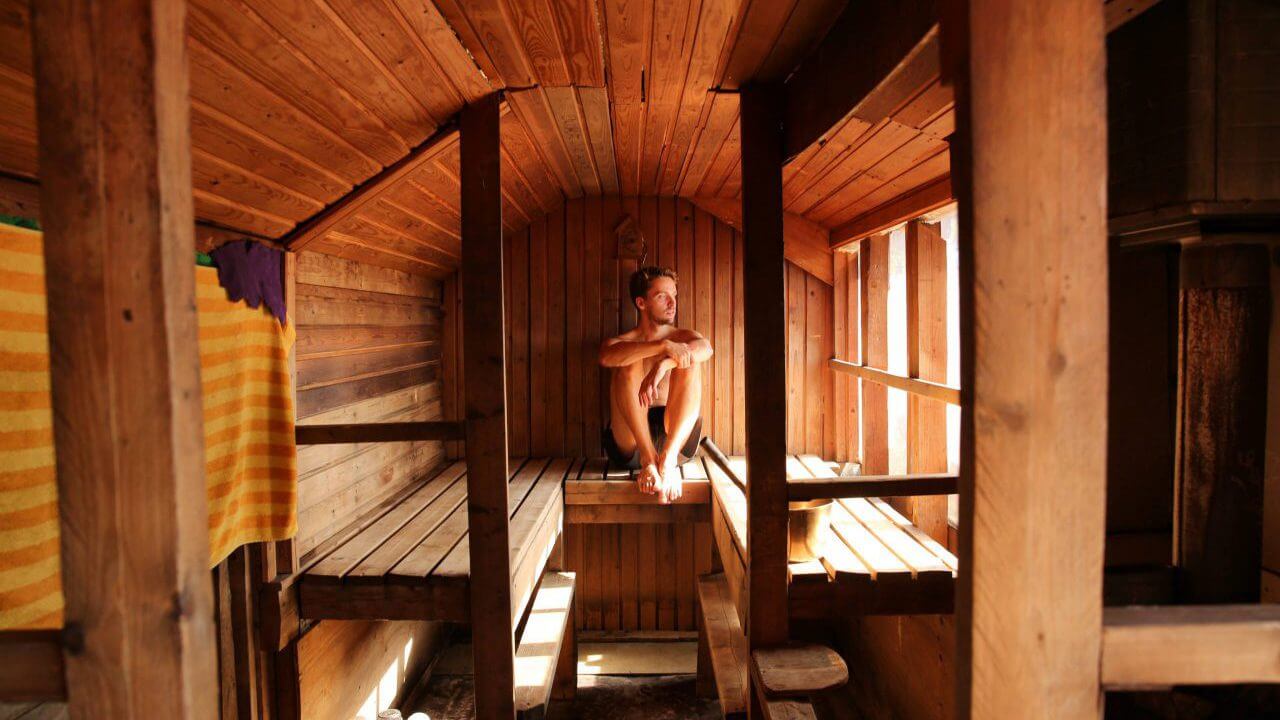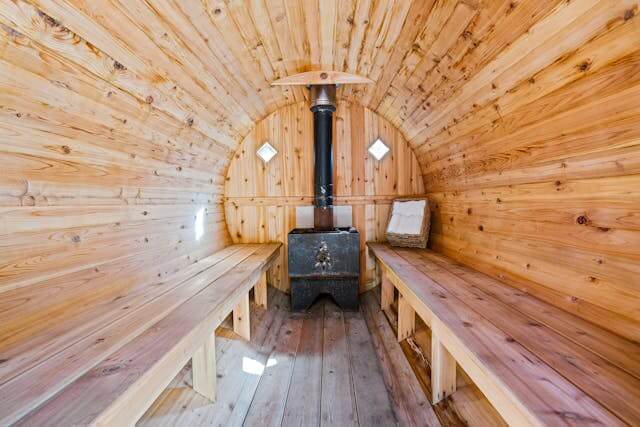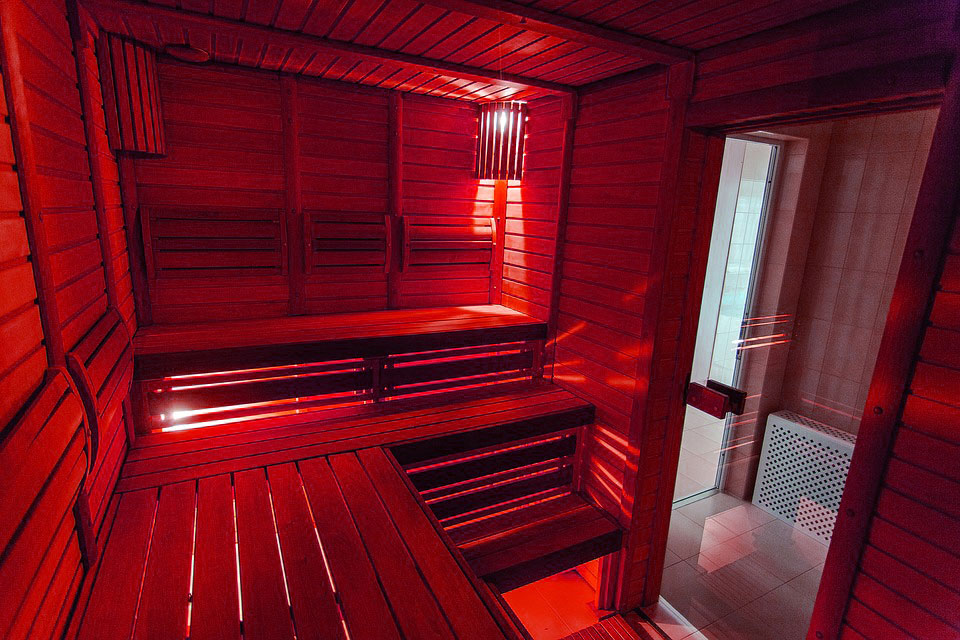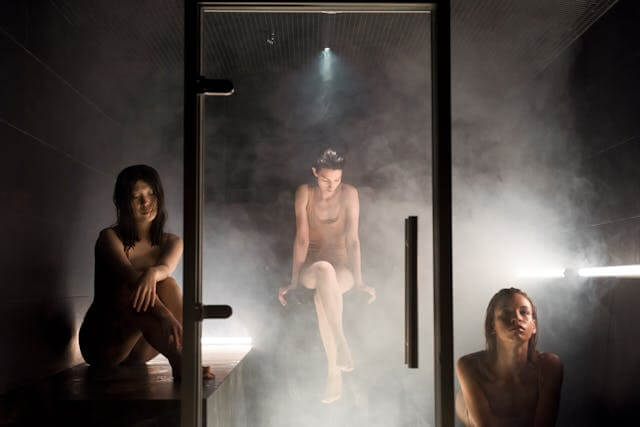Saunatyp: Dauer, Kalorienverbrauch, und ideale Temperatur
Saunatyp: Dauer, Kalorienverbrauch, und ideale Temperatur
Wie lange sollte man in der Sauna bleiben??
Die optimale Länge einer Sauna kann je nach einer Reihe von Faktoren variieren, einschließlich Ihrer Erfahrung, die Art der Sauna, und Ihre persönliche Gesundheit.
Für Anfänger, Normalerweise wird vorgeschlagen, mit kürzeren Sitzungen der Begleitung zu beginnen 5-10 Protokoll. Dies ermöglicht Ihrem Körper, sich langsam an das warme anzupassen. Viel mehr erfahrenere Kunden können ihre Sitzungen auf die Sitzungen erweitern 15-20 mins, Dies wird normalerweise über den angenehmen Bereich für die meisten Menschen gedacht, um zu profitieren, ohne sich selbst anzustrengen.
Es ist auch wichtig, sich daran zu erinnern, dass verschiedene Saunen unterschiedliche ideale Sitzungszeiten haben können:
| Sauna | Ratendauer |
|---|---|
| Traditionelle finnische Sauna | 15-20 mins |
| Infrarotsauna | 20-30 mins |
| Dampfsauna | 10-15 mins |

Es ist sehr wichtig, sich während der Sauna um Ihren Körper zu kümmern. Wenn Sie sich schwindelig fühlen, benommen oder unangenehm, Es ist ratsam, die Sauna sofort zu verlassen und sich zu beruhigen. Die Flüssigkeitszufuhr ist ebenfalls wichtig; Stellen Sie sicher, dass Sie vor und nach der Sauna viel Wasser trinken, um hydratisiert zu bleiben.
Abschließend, Während die ideale Sauna -Zeit variieren kann, Die allgemeine Richtlinie besteht darin, mit einer kürzeren Zeit zu beginnen und die Zeit langsam zu erhöhen, wenn Sie sich mit der Sauna vertraut machen. Priorisieren Sie immer Ihren Komfort und Ihre Sicherheit, um das Beste aus Ihrer Sauna -Erfahrung.
Wie viele Kalorien verbrennen Sie in einer Sauna??
Wenn es sich um Kalorienbrand in einer Sauna handelt, Es ist wichtig, die Mechanismen im Spiel zu verstehen. Die primäre Art und Weise, wie eine Sauna beim Verbrennen von Kalorien hilft. Während Sie in einer Sauna sitzen, Ihre Herzfrequenz kann ähnlich wie das während des bescheidenen Trainings steigern. Diese erhöhte Herzfrequenz erfordert mehr Kraft, die anschließend Kalorien verbrennt.
Dennoch, Die Anzahl der in einer Sauna -Sitzung verbrannten Kalorien kann sich erheblich auf zahlreichen Aspekten unterscheiden. Diese bestehen aus dem Gewicht des Individuums, das Temperaturniveau der Sauna, und die Zeitraum der Sitzung. Durchschnittlich, Eine 30-minütige Sitzung in einer Sauna kann dazwischen verschoben werden 150 Zu 300 Kalorien. Es ist notwendig zu bedenken, dass dies zwar eine wertvolle Ergänzung zu einem Fitnessregime ist, Es muss nicht als alleiniger Ansatz für die Gewichtsreduzierung abhängig sein.
| Zeit (Protokoll) | 45°C | 60°C | 75°C | 90°C | 105°C |
|---|---|---|---|---|---|
| 15 | 51.8 | 62.0 | 75.5 | 88.9 | 102.4 |
| 30 | 103.5 | 124.0 | 151.0 | 177.8 | 204.8 |
| 45 | 155.3 | 186.0 | 226.5 | 266.7 | 307.2 |
| 60 | 207.0 | 248.0 | 302.0 | 355.6 | 409.6 |

Bestimmen Sie die Zeit in der Sauna:
Berechnen Sie die verbrannten Kalorien:
Durchschnittlich, Eine Person brennt herum 500 Kcal pro Stunde in einer Sauna.
Verwenden Sie die Formel:
Kalorien verbrannte[𝑘𝑐𝑎𝑙]=(𝑡/60) × 500
Wo “𝑡” ist die Zeit in Minuten.
Gewichtsverlust berechnen:
Verwenden Sie die Formel:
Gewichtsverlust[𝑘𝑔]=Calories burned[𝑘𝑐𝑎𝑙]/7700
Wo 7700 kcal is approximately the energy required to lose 1 kilogram of body weight.
It is worth noting that the initial weight loss after a sauna is mainly due to water loss from sweating. Weight is usually regained after rehydration. daher, while saunas can be an effective tool for burning calories, they should be combined with a balanced diet and regular exercise for lasting weight management.
Tips for Making The Most Of Calorie Burn in a Sauna
| Tip | Description |
| Optimize Session Duration | Stay in the sauna for 15-20 minutes per session. Longer sessions can cause dehydration and health risks, while shorter sessions may not be as effective. |
| Choose the Right Temperature | For traditional saunas, set the temperature between 150°F and 195°F (65°C to 90°C). For infrared saunas, Stellen Sie es zwischen 120 ° F und 140 ° F ein (50° C bis 60 ° C.). |
| Bleiben Sie hydratisiert | Wasser vor Wasser trinken, während, Und nach Ihrer Sauna -Sitzung, um die Fähigkeit Ihres Körpers zu schwitzen und die Temperatur zu regulieren. |
| Lichtübungen einbeziehen | Führen Sie sanfte Übungen wie Stretching oder Yoga durch, um die Herzfrequenz zu erhöhen und die Kalorienverbrennung zu verbessern. Vermeiden Sie intensive Aktivitäten, um Verletzungen zu verhindern. |
| Verwenden Sie nach dem Training | Nutzen Sie die Sauna nach einem Training, um die erhöhte Herzfrequenz und Stoffwechselrate zu verlängern, was zu zusätzlichen Kalorienausgaben führt. |
| Überwachen Sie die Reaktion Ihres Körpers | Passen Sie die Dauer und Häufigkeit von Sauna -Sitzungen an, basierend auf Ihrer persönlichen Toleranz- und Komfortniveaus, um die Leistungen sicher zu maximieren. |
Wie heiß sollte eine Sauna sein?
Wenn es darum geht, Ihre Sauna -Erfahrung zu maximieren, Das Verständnis der hervorragenden Temperatureinstellungen für verschiedene Sauna -Typen ist wichtig. Jede Art von Sauna arbeitet in einem bestimmten Temperaturniveau -Array am besten, um sicherzustellen, dass sowohl Sicherheit als auch Effizienz. Unten, Ich werde sicherlich die vorgeschlagenen Temperaturniveaus -Setups für die häufigsten Arten von Saunen skizzieren: Typische finnische Saunen, Infrarot -Saunen, und Dampfsaunen.
Traditionelle finnische Sauna

Traditionelle finnische Saunen, bekannt für ihre hohen Temperaturniveaus und niedrigen Feuchtigkeit, Normalerweise innerhalb einer Vielzahl von einer Vielzahl von arbeiten 70 ° C bis 100 ° C( 158 ° F bis 212 ° F ). Diese hohe Wärmeeinstellung ist optimal für die Werbung intensives Schwitzen und Freizeit. Für Anfänger, Es wird empfohlen, am reduzierten Ende dieses Bereichs zu beginnen und das Temperaturniveau schrittweise zu erhöhen, wenn Sie mit der Wärme besser vertraut sind.
Infrarotsaunen

Infrared saunas function in different ways from traditional saunas by using infrared heating units to release radiant warm, which is soaked up straight by the body. The ideal temperature level range for infrared saunas is normally lower, in between 45 ° C bis 60 ° C(113 ° F bis 140 ° F). This reduced temperature permits an extra long term session, usually as much as 45 mins, while still giving the benefits of deep cells home heating and cleansing.
Dampfsauna

Vapor saunas, likewise referred to as steam areas, incorporate high moisture with modest temperatures. The excellent temperature level for a heavy steam sauna typically drops in between 40 ° C bis 50 ° C(104 ° F bis 122 ° F). The high humidity, usually around 100%, intensifies the sensation of warm and advertises sweating. This setting is specifically valuable for respiratory wellness and skin hydration.
| Sauna Type | Recommended Temperature Range | Main Features |
| Traditionelle finnische Sauna | 70°C to 100°C (158°F to 212°F) | High temperature, low humidity; promotes intense sweating and relaxation. |
| Infrarotsauna | 45° C bis 60 ° C. (113°F to 140°F) | Lower temperature; suitable for longer sessions, provides deep tissue heating and cleansing effects. |
| Dampfsauna | 40°C to 50°C (104°F to 122°F) | Moderate temperature with high humidity; enhances sensation of heat, promotes sweating, beneficial for respiratory health and skin hydration. |
By adhering to these excellent temperature settings, you can optimize the advantages of your sauna sessions while making sure a secure and delightful experien
6 Health Benefits of Regular Sauna Use
- Enhanced cardio wellness: The warmth from the sauna causes blood vessels to dilate, which subsequently enhances blood circulation and reduces blood stress. This can be specifically useful for individuals wanting to boost their heart health and wellness.
- Muscular tissue leisure and healing: The heats in the sauna assistance to loosen up muscle mass and reduce tension, making it an exceptional technique for professional athletes or any person experiencing muscular tissue pain. The heat likewise promotes the release of endorphins, which are natural painkiller produced by the body.
- Entgiftung: Sweating is among the body’s all-natural methods to eliminate toxic substances, and the intense heat of a sauna generates a deep sweat, helping to eliminate impurities from the body. This detoxifying result can result in more clear skin and a healthier general skin.
- Improve respiratory system function: The cozy, damp setting of a sauna can help to open air passages, decrease congestion, and promote less complicated breathing. Dies kann speziell für Personen mit Atemproblemen wie Asthma oder Bronchitis hilfreich sein.
- Stress und Angstverringerung: Die beruhigende Atmosphäre einer Sauna, kombiniert mit der Wärme, kann helfen, das Angstniveau zu senken und die Freizeit zu fördern. Dies kann zu einer stärkeren psychischen Gesundheit und Wohlbefinden und einer viel besseren hohen Ruhequalität führen.
- Steigende Immunfunktion: Die warme direkte Belichtung kann die Herstellung von Leukozyten erhöhen, die für die Bekämpfung von Infektionen und Krankheiten wesentlich sind. Dieser Immun-Boosting-Auswirkungen kann dazu beitragen, den Körper gesünder und viel resistenter zu halten.
Wann nach dem Abendessen zu Sauna?
Der grundlegende Vorschlag besteht darin, dazwischen zu warten 1.5 Zu 2 Stunden nach Ihrem Gericht, bevor Sie in die Sauna eintreten. Dieser Zeitrahmen ermöglicht es Ihrem Körper, das Verdauungsverfahren für Lebensmittel initiieren zu können, Vermeiden Sie die Stress für Ihr System während der gesamten Wärmexposition.
Die genaue Wartezeit kann je nach Größe und Art des verbrauchten Gerichts unterschiedlich sein. Als Beispiel, Leichtere Gerichte, einschließlich Salate oder Suppen 1 Zu 1.5 Std.. Auf der anderen Seite, viel schwerere Gerichte, vor allem diejenigen, die reich an Fetten und gesunden Proteinen sind, kann fordern, näher an der 2-stündigen Marke zu warten. Im Folgenden finden Sie eine Richtlinie für Schüsselarten und empfohlen die Wartezeiten:
| Art der Mahlzeit | Empfohlene Wartezeit |
|---|---|
| Snack (Salate, Suppen) | 1 – 1.5 Std. |
| Bescheidene Mahlzeit (Pasta, Gegrilltes Gemüse) | 1.5 – 2 Std. |
| Schweres Essen (Steak, Gebratene Lebensmittel) | 2 Std. |
Sicherheitsvorkehrungen für die Anwendung von Sauna
| Sicherheitsvorsorge | Description |
| Bleiben Sie hydratisiert | Trinken Sie vorher viel Wasser, während, und nach Ihrer Sauna -Sitzung, um Dehydration zu verhindern. |
| Überwachen Sie die Sitzungsdauer | Beschränken Sie die Sitzungen auf 15-20 Minuten, um Überhitzung und andere Gesundheitsprobleme zu vermeiden. |
| Vermeiden Sie Alkohol und Drogen | Do not consume alcohol or use recreational drugs before or during a sauna session. |
| Use Proper Sauna Etiquette | Shower before entering, sit on a towel, and keep noise levels respectful. |
| Exit Safely | Exit gradually to avoid a sudden drop in blood pressure, sit before standing, and move slowly to a cooler area. |
Das Geschäft vor ihm
Saunatyp: Dauer, Kalorienverbrauch, und ideale Temperatur
Wie lange sollte man in der Sauna bleiben??
Die optimale Länge einer Sauna kann je nach einer Reihe von Faktoren variieren, einschließlich Ihrer Erfahrung, die Art der Sauna, und Ihre persönliche Gesundheit.
Für Anfänger, Normalerweise wird vorgeschlagen, mit kürzeren Sitzungen der Begleitung zu beginnen 5-10 Protokoll. Dies ermöglicht Ihrem Körper, sich langsam an das warme anzupassen. Viel mehr erfahrenere Kunden können ihre Sitzungen auf die Sitzungen erweitern 15-20 mins, Dies wird normalerweise über den angenehmen Bereich für die meisten Menschen gedacht, um zu profitieren, ohne sich selbst anzustrengen.
Es ist auch wichtig, sich daran zu erinnern, dass verschiedene Saunen unterschiedliche ideale Sitzungszeiten haben können:
| Sauna | Ratendauer |
|---|---|
| Traditionelle finnische Sauna | 15-20 mins |
| Infrarotsauna | 20-30 mins |
| Dampfsauna | 10-15 mins |

Es ist sehr wichtig, sich während der Sauna um Ihren Körper zu kümmern. Wenn Sie sich schwindelig fühlen, benommen oder unangenehm, Es ist ratsam, die Sauna sofort zu verlassen und sich zu beruhigen. Die Flüssigkeitszufuhr ist ebenfalls wichtig; Stellen Sie sicher, dass Sie vor und nach der Sauna viel Wasser trinken, um hydratisiert zu bleiben.
Abschließend, Während die ideale Sauna -Zeit variieren kann, Die allgemeine Richtlinie besteht darin, mit einer kürzeren Zeit zu beginnen und die Zeit langsam zu erhöhen, wenn Sie sich mit der Sauna vertraut machen. Priorisieren Sie immer Ihren Komfort und Ihre Sicherheit, um das Beste aus Ihrer Sauna -Erfahrung.
Wie viele Kalorien verbrennen Sie in einer Sauna??
Wenn es sich um Kalorienbrand in einer Sauna handelt, Es ist wichtig, die Mechanismen im Spiel zu verstehen. Die primäre Art und Weise, wie eine Sauna beim Verbrennen von Kalorien hilft. Während Sie in einer Sauna sitzen, Ihre Herzfrequenz kann ähnlich wie das während des bescheidenen Trainings steigern. Diese erhöhte Herzfrequenz erfordert mehr Kraft, die anschließend Kalorien verbrennt.
Dennoch, Die Anzahl der in einer Sauna -Sitzung verbrannten Kalorien kann sich erheblich auf zahlreichen Aspekten unterscheiden. Diese bestehen aus dem Gewicht des Individuums, das Temperaturniveau der Sauna, und die Zeitraum der Sitzung. Durchschnittlich, Eine 30-minütige Sitzung in einer Sauna kann dazwischen verschoben werden 150 Zu 300 Kalorien. Es ist notwendig zu bedenken, dass dies zwar eine wertvolle Ergänzung zu einem Fitnessregime ist, Es muss nicht als alleiniger Ansatz für die Gewichtsreduzierung abhängig sein.
| Zeit (Protokoll) | 45°C | 60°C | 75°C | 90°C | 105°C |
|---|---|---|---|---|---|
| 15 | 51.8 | 62.0 | 75.5 | 88.9 | 102.4 |
| 30 | 103.5 | 124.0 | 151.0 | 177.8 | 204.8 |
| 45 | 155.3 | 186.0 | 226.5 | 266.7 | 307.2 |
| 60 | 207.0 | 248.0 | 302.0 | 355.6 | 409.6 |

Bestimmen Sie die Zeit in der Sauna:
Berechnen Sie die verbrannten Kalorien:
Durchschnittlich, Eine Person brennt herum 500 Kcal pro Stunde in einer Sauna.
Verwenden Sie die Formel:
Kalorien verbrannte[𝑘𝑐𝑎𝑙]=(𝑡/60) × 500
Wo “𝑡” ist die Zeit in Minuten.
Gewichtsverlust berechnen:
Verwenden Sie die Formel:
Gewichtsverlust[𝑘𝑔]=Calories burned[𝑘𝑐𝑎𝑙]/7700
Wo 7700 kcal is approximately the energy required to lose 1 kilogram of body weight.
It is worth noting that the initial weight loss after a sauna is mainly due to water loss from sweating. Weight is usually regained after rehydration. daher, while saunas can be an effective tool for burning calories, they should be combined with a balanced diet and regular exercise for lasting weight management.
Tips for Making The Most Of Calorie Burn in a Sauna
| Tip | Description |
| Optimize Session Duration | Stay in the sauna for 15-20 minutes per session. Longer sessions can cause dehydration and health risks, while shorter sessions may not be as effective. |
| Choose the Right Temperature | For traditional saunas, set the temperature between 150°F and 195°F (65°C to 90°C). For infrared saunas, Stellen Sie es zwischen 120 ° F und 140 ° F ein (50° C bis 60 ° C.). |
| Bleiben Sie hydratisiert | Wasser vor Wasser trinken, während, Und nach Ihrer Sauna -Sitzung, um die Fähigkeit Ihres Körpers zu schwitzen und die Temperatur zu regulieren. |
| Lichtübungen einbeziehen | Führen Sie sanfte Übungen wie Stretching oder Yoga durch, um die Herzfrequenz zu erhöhen und die Kalorienverbrennung zu verbessern. Vermeiden Sie intensive Aktivitäten, um Verletzungen zu verhindern. |
| Verwenden Sie nach dem Training | Nutzen Sie die Sauna nach einem Training, um die erhöhte Herzfrequenz und Stoffwechselrate zu verlängern, was zu zusätzlichen Kalorienausgaben führt. |
| Überwachen Sie die Reaktion Ihres Körpers | Passen Sie die Dauer und Häufigkeit von Sauna -Sitzungen an, basierend auf Ihrer persönlichen Toleranz- und Komfortniveaus, um die Leistungen sicher zu maximieren. |
Wie heiß sollte eine Sauna sein?
Wenn es darum geht, Ihre Sauna -Erfahrung zu maximieren, Das Verständnis der hervorragenden Temperatureinstellungen für verschiedene Sauna -Typen ist wichtig. Jede Art von Sauna arbeitet in einem bestimmten Temperaturniveau -Array am besten, um sicherzustellen, dass sowohl Sicherheit als auch Effizienz. Unten, Ich werde sicherlich die vorgeschlagenen Temperaturniveaus -Setups für die häufigsten Arten von Saunen skizzieren: Typische finnische Saunen, Infrarot -Saunen, und Dampfsaunen.
Traditionelle finnische Sauna

Traditionelle finnische Saunen, bekannt für ihre hohen Temperaturniveaus und niedrigen Feuchtigkeit, Normalerweise innerhalb einer Vielzahl von einer Vielzahl von arbeiten 70 ° C bis 100 ° C( 158 ° F bis 212 ° F ). Diese hohe Wärmeeinstellung ist optimal für die Werbung intensives Schwitzen und Freizeit. Für Anfänger, Es wird empfohlen, am reduzierten Ende dieses Bereichs zu beginnen und das Temperaturniveau schrittweise zu erhöhen, wenn Sie mit der Wärme besser vertraut sind.
Infrarotsaunen

Infrared saunas function in different ways from traditional saunas by using infrared heating units to release radiant warm, which is soaked up straight by the body. The ideal temperature level range for infrared saunas is normally lower, in between 45 ° C bis 60 ° C(113 ° F bis 140 ° F). This reduced temperature permits an extra long term session, usually as much as 45 mins, while still giving the benefits of deep cells home heating and cleansing.
Dampfsauna

Vapor saunas, likewise referred to as steam areas, incorporate high moisture with modest temperatures. The excellent temperature level for a heavy steam sauna typically drops in between 40 ° C bis 50 ° C(104 ° F bis 122 ° F). The high humidity, usually around 100%, intensifies the sensation of warm and advertises sweating. This setting is specifically valuable for respiratory wellness and skin hydration.
| Sauna Type | Recommended Temperature Range | Main Features |
| Traditionelle finnische Sauna | 70°C to 100°C (158°F to 212°F) | High temperature, low humidity; promotes intense sweating and relaxation. |
| Infrarotsauna | 45° C bis 60 ° C. (113°F to 140°F) | Lower temperature; suitable for longer sessions, provides deep tissue heating and cleansing effects. |
| Dampfsauna | 40°C to 50°C (104°F to 122°F) | Moderate temperature with high humidity; enhances sensation of heat, promotes sweating, beneficial for respiratory health and skin hydration. |
By adhering to these excellent temperature settings, you can optimize the advantages of your sauna sessions while making sure a secure and delightful experien
6 Health Benefits of Regular Sauna Use
- Enhanced cardio wellness: The warmth from the sauna causes blood vessels to dilate, which subsequently enhances blood circulation and reduces blood stress. This can be specifically useful for individuals wanting to boost their heart health and wellness.
- Muscular tissue leisure and healing: The heats in the sauna assistance to loosen up muscle mass and reduce tension, making it an exceptional technique for professional athletes or any person experiencing muscular tissue pain. The heat likewise promotes the release of endorphins, which are natural painkiller produced by the body.
- Entgiftung: Sweating is among the body’s all-natural methods to eliminate toxic substances, and the intense heat of a sauna generates a deep sweat, helping to eliminate impurities from the body. This detoxifying result can result in more clear skin and a healthier general skin.
- Improve respiratory system function: The cozy, damp setting of a sauna can help to open air passages, decrease congestion, and promote less complicated breathing. Dies kann speziell für Personen mit Atemproblemen wie Asthma oder Bronchitis hilfreich sein.
- Stress und Angstverringerung: Die beruhigende Atmosphäre einer Sauna, kombiniert mit der Wärme, kann helfen, das Angstniveau zu senken und die Freizeit zu fördern. Dies kann zu einer stärkeren psychischen Gesundheit und Wohlbefinden und einer viel besseren hohen Ruhequalität führen.
- Steigende Immunfunktion: Die warme direkte Belichtung kann die Herstellung von Leukozyten erhöhen, die für die Bekämpfung von Infektionen und Krankheiten wesentlich sind. Dieser Immun-Boosting-Auswirkungen kann dazu beitragen, den Körper gesünder und viel resistenter zu halten.
Wann nach dem Abendessen zu Sauna?
Der grundlegende Vorschlag besteht darin, dazwischen zu warten 1.5 Zu 2 Stunden nach Ihrem Gericht, bevor Sie in die Sauna eintreten. Dieser Zeitrahmen ermöglicht es Ihrem Körper, das Verdauungsverfahren für Lebensmittel initiieren zu können, Vermeiden Sie die Stress für Ihr System während der gesamten Wärmexposition.
Die genaue Wartezeit kann je nach Größe und Art des verbrauchten Gerichts unterschiedlich sein. Als Beispiel, Leichtere Gerichte, einschließlich Salate oder Suppen 1 Zu 1.5 Std.. Auf der anderen Seite, viel schwerere Gerichte, vor allem diejenigen, die reich an Fetten und gesunden Proteinen sind, kann fordern, näher an der 2-stündigen Marke zu warten. Im Folgenden finden Sie eine Richtlinie für Schüsselarten und empfohlen die Wartezeiten:
| Art der Mahlzeit | Empfohlene Wartezeit |
|---|---|
| Snack (Salate, Suppen) | 1 – 1.5 Std. |
| Bescheidene Mahlzeit (Pasta, Gegrilltes Gemüse) | 1.5 – 2 Std. |
| Schweres Essen (Steak, Gebratene Lebensmittel) | 2 Std. |
Sicherheitsvorkehrungen für die Anwendung von Sauna
| Sicherheitsvorsorge | Description |
| Bleiben Sie hydratisiert | Trinken Sie vorher viel Wasser, während, und nach Ihrer Sauna -Sitzung, um Dehydration zu verhindern. |
| Überwachen Sie die Sitzungsdauer | Beschränken Sie die Sitzungen auf 15-20 Minuten, um Überhitzung und andere Gesundheitsprobleme zu vermeiden. |
| Vermeiden Sie Alkohol und Drogen | Do not consume alcohol or use recreational drugs before or during a sauna session. |
| Use Proper Sauna Etiquette | Shower before entering, sit on a towel, and keep noise levels respectful. |
| Exit Safely | Exit gradually to avoid a sudden drop in blood pressure, sit before standing, and move slowly to a cooler area. |
Über den Autor

Willkommen auf unserem Blog! Mein Name ist Peter und ich bin der Hauptautor dieses Blogs. Als Sport-Recovery-Praktiker mit tiefem Interesse und Fachwissen.
Es liegt mir am Herzen, komplexe Konzepte klar und prägnant darzustellen, und es den Lesern zu ermöglichen, dieses Wissen durch eingehende Recherche und Erfahrungsaustausch besser zu verstehen und anzuwenden.
Vielen Dank fürs Lesen und für Ihre Unterstützung! Wenn Sie Fragen oder Anregungen zu den Inhalten haben, zögern Sie nicht, mich zu kontaktieren. Ich freue mich darauf, weitere interessante und nützliche Informationen mit Ihnen zu teilen und gemeinsam auf dieser Wissensreise zu wachsen!
